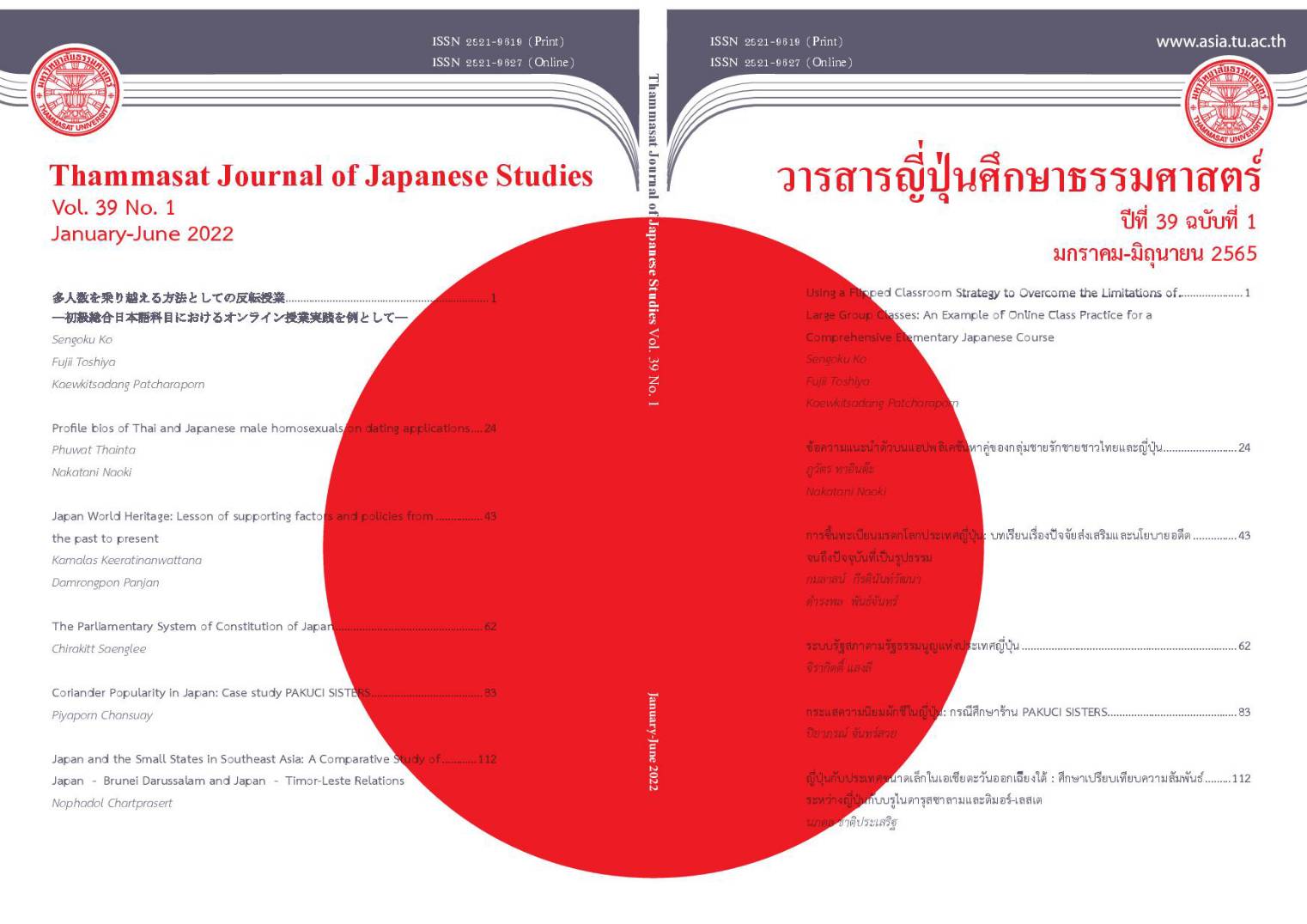Using a Flipped Classroom Strategy to Overcome the Limitations of Large Group Classes
: An Example of Online Class Practice for a Comprehensive Elementary Japanese Course
คำสำคัญ:
日本語教育, 初級総合日本語, 反転授業, 自己表現, オンライン授業บทคัดย่อ
This case study presents an example of how teachers might implement practices that provide students with opportunities for self-expression and a fuller sense of learning in Japanese language classes in Thailand, where class sizes tend to be large and sentence-based syllabi are widely used. The authors developed a three-shift flipped classroom curriculum for an online, comprehensive elementary Japanese course, and surveyed students through a questionnaire. Students report that the flipped classroom format made the lecture content more accessible, and the smaller class sizes and three-shift system provided students with greater opportunities for self-expression and interpersonal communication in Japanese, which enhanced student satisfaction and self-reported learning outcomes.
The authors conclude that the shift system achieved through a flipped classroom strategy has wide application for overcoming the problems associated with large class sizes in Japanese language classes in Thailand, beyond the present use in online courses.
Downloads
เอกสารอ้างอิง
Bergmann, J., & Sams, A. (2012). Flip your classroom: reach every student in every class every day. International Society for Technology in Education, The Association for Supervision and Curriculum Development.
Japan Foundation. (2019). Survey Report on Japanese-language Education Abroad 2018. https://www.jpf.go.jp/j/project/japanese/survey/result/dl/survey2018/Report_all_e.pdf
Kaewkitsadang, P. (2017). Can-Do Statement Based Japanese Language Education: Study for Application to Create New Curriculum and Japanese Language Textbooks for Undergraduate Students in Thailand. Journal of International Center for Japanese Studies, 7, 111-127. (in Japanese)
Kitaguchi, N., Yamaguchi, Y., & Yoshida, N. (2012). Trends in CEFR and Evaluation Standards of Japanese Language Education- An Attempt to Create TU Standards at Thammasat University. Japanese Studies Journal, 29(1), 97-108.
Laohaburanakit, K.K. (2012). Japanese Language Standards for Speaking and Listening Skills for University Students Majoring in Japanese: A Case Study of Chulalongkorn University. Journal of Letters, 41(1), 1-35.
Limvong, T., & Saengri, Y. (2019). Flipped Classroom: new learning for 21st Century Skills. Mahido R2R e-Journal, 6(2), 9-17. http://doi.org/10.14456/jmu.2019.10 (in Thai)
Ministry of Education Culture Sports Science and Technology. (2021). Survey Report on the effect of Covid-19 on Student Life. https://www.mext.go.jp/content/20210525-mxt_kouhou01-000004520_1.pdf
Mori, T. (2016). Design of flipped classroom. Chemistry & education, 64(12), 596-599. (in Japanese)
Sakulprasertsri, K., & Vibulphol, J. (2016). Effects of English Instruction Using the Flipped Learning Approach on English Oral Communication Ability and Motivation in English Learning of Upper Secondary School Students. Journal
of Education Studies, 44(3), 29-45.
Schmidt, Stacy M.P., & Ralph, D.L. (2016). The Flipped Classroom: A Twist on Teaching. Contemporary Issues in Education Research-First Quarter, 9(1), 1-6.
Stone, B. B. (2012). Flip Your Classroom to Increase Active Learning and Student Engagement. 28th Annual Conference on Distance Teaching & Learning. 1-5.
Yamauchi, Y., & Oura, H. (2014). Preface. In Bergman, J., & Sams, A. Flipped Classroom. (translation supervised by Yuhei Yamauchi). pp.3-12. (in Japanese)
Yang, Chi Cheung Ruby. (2017). An Investigation of the use of the ‘flipped classroom’ pedagogy in secondary English language classrooms. Journal of Information Technology Education: Innovations in Practice,16(1), 1-20.
Yixing, L. (2015). Flipped Classroom Theories of Japanese Teaching. http://www.atlantispress.com/php/download_paper.php?!d=25840762 (in Thai)
Yoshida, N., & Treeratsakulchai, T. (2016). A Study of Learning Achievement of Basic Japanese 1 by Using the Flipped Classroom for Non-Japanese Major Students of Chiang Mai University. jsn Journal, 6(2), 71-83. https://doi.org/10.14456/jsnjournal.2016.5. (in Thai)
ดาวน์โหลด
เผยแพร่แล้ว
ฉบับ
ประเภทบทความ
สัญญาอนุญาต
ลิขสิทธิ์ (c) 2022 วารสารญี่ปุ่นศึกษาธรรมศาสตร์

อนุญาตภายใต้เงื่อนไข Creative Commons Attribution-NonCommercial-NoDerivatives 4.0 International License.




